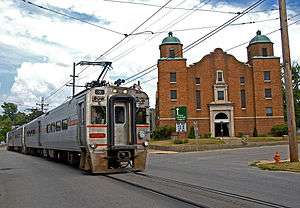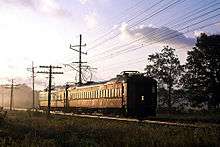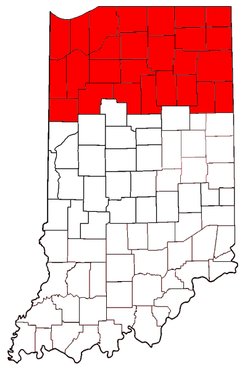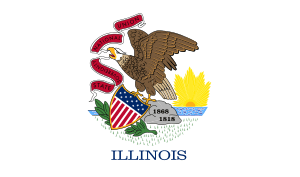South Shore Line
The South Shore Line (reporting mark NICD) is an electrically powered interurban commuter rail line operated by the Northern Indiana Commuter Transportation District (NICTD) between Millennium Station in downtown Chicago and the South Bend International Airport in South Bend, Indiana. The name refers to both the physical line and the service operated over that route. The line was built in 1901–08 by predecessors of the Chicago South Shore and South Bend Railroad, which continues to operate freight service. Passenger operation was assumed by the NICTD in 1989.
Service
The public Monday-Friday timetable shows 20 eastbound trains operating. 18 of those operate out of Millennium Station. Of those, 5 terminate at Gary Metro Center, 7 at South Bend Airport, and 10 at Carroll Ave. Two daily trains start at Carroll Ave. and continue to South Bend Airport.
History
Private operation
The South Shore Line was constructed between 1901–08 by the Chicago and Indiana Air Line Railway (reorganized as the Chicago, Lake Shore and South Bend Railway in 1904). Revenue service between Michigan City and South Bend began on July 1, 1908. The Lake Shore leased the Kensington and Eastern Railroad on April 4, 1909, giving it access to Chicago. That year the full line to Kensington on the Illinois Central was completed, and beginning on June 2, 1912, the electric cars were coupled to IC steam locomotives and run to downtown Chicago.[2]

The Lake entered bankruptcy in 1925 and was bought by Samuel Insull's Chicago South Shore and South Bend Railroad (CSS&SB).[3] The line continued to handle both freight and passengers. Under Insull, the company embarked on a major rehabilitation program. This included new ballast and ties, 100-pound (45 kg) rail in place of 70-pound (32 kg) rail, brush clearance, and an overhaul of the line's block signals.[4] In 1946 the company acquired three Little Joe electric locomotives for freight service. These locomotives had originally been constructed for the Soviet Union, but changing attitudes due to the Cold War prevented them from being delivered. These locomotives continued in freight service on the South Shore until 1983, making them the last electric locomotives in regular freight service in the United States. One, number 803, is preserved in running condition at the Illinois Railway Museum.
The power system was changed from 6600 volts AC to 1500 volts DC on July 28, 1926, allowing trains to operate directly to the Illinois Central's Randolph Street Terminal without an engine change. Trains began running to Chicago on August 29.[5] That same year, the original line between East Chicago and Indiana Harbor was abandoned.[2]
The CSS&SB turned a profit during World War II due to the industrial nature of Northern Indiana. However, highway competition and suburban growth led to ridership declines. By the 1950s all interurban lines were seeing a decline in rail travel as automobile use increased.[6] On September 16, 1956, a street running section in East Chicago was removed with the building of a new alignment alongside the Indiana Toll Road. A truncation to west of downtown South Bend removed street trackage in that city from July 1, 1970.[2]
The Chesapeake and Ohio Railway acquired the CSS&SB on January 3, 1967 and continued the operation of passenger services.[7] The CSS&SB was one of six railroads with "long-distance" passenger services to decline joining Amtrak in 1971 and in 1976, they asked the Interstate Commerce Commission to abandon passenger service. The ICC gave the State of Indiana a chance to reply and subsequently, the Northern Indiana Commuter Transportation District was formed in 1977 to fund the service. When the railway went bankrupt, passenger service was taken over by the NICTD in December 1989. In December 1990, the track was sold to the NICTD and freight service was taken over by the new Chicago South Shore and South Bend Railroad, a subsidiary of short line operator Anacostia and Pacific.
Public operation

On November 21, 1992, the line's South Bend terminus moved from the Amtrak station to the airport.[8] On July 5, 1994, NICTD closed the Ambridge, Kemil Road, Willard Avenue, LaLumiere, Rolling Prairie, and New Carlisle flag stops. A seventh station, Dune Acres, closed around the same time once parking was expanded at nearby Dune Park.[9]
The railroad began a three-year project in 2009 to replace all catenary on its line between Michigan City and Gary, some of which was nearly 90 years old. The project cost $18 million, and caused service disruptions on weekends (five in August–October 2009, one in May 2010 and five more in August–November 2010) while new wires were strung. The 2009 and 2010 weekend outages truncated trains at Gary Metro Center.[10] During the August–November 2010 disruptions Amtrak's Wolverine provided service to the Amtrak Michigan City station.[11]
In 2015 NICTD began an express service between South Bend and Chicago. Targeted at business travelers, the train will make just two intermediate stops: Dune Park and East Chicago. The total scheduled travel time is 1 hour 55 minutes, more than thirty minutes faster than existing services.[12]
Route
Departing South Bend Airport, the South Shore Line heads south alongside Bendix Drive, then west along Westmoor Street, before connecting with the tracks that ran to its former terminus. Between that point and Hudson Lake, Indiana, the South Shore Line runs parallel to Norfolk Southern's Chicago Line, also used by Amtrak's Lake Shore Limited and Capitol Limited, on the north side of the tracks. Just before Hudson Lake, the line crosses from St. Joseph County into LaPorte County and enters the Central Time Zone.
From Hudson Lake, the South Shore continues straight west to Michigan City. In Michigan City, the track runs down the middle of 11th street from Michigan Boulevard to Tennessee Street, where it crosses over to Tenth Street, and has an at-grade diamond with Amtrak's Michigan Services. The track then runs down Tenth Street to Sheridan Avenue on the west side of Michigan City. Leaving Michigan City, the track travels through Indiana Dunes State Park, crosses over the Chicago Line and runs parallel to it, this time on the south side, past Long Lake. At Gary, Indiana, the route heads west to service the Gary Airport, at times running parallel to the Indiana Toll Road, as far as Hammond, Indiana. Just west of the Hammond station, the route crosses into Illinois and Chicago city limits, at which point the track curves northwest, through the Hegewisch neighborhood and, after crossing the Bishop Ford Freeway and the Calumet River, converges with the Metra Electric line south of Kensington/115th Street station. The South Shore Line then runs over the Metra Electric tracks from Kensington/115th Street the rest of the way to Millennium Station.
The line is double-tracked from Kensington/115th Street to just east of Gary Metro Center. From there it is single-tracked with passing sidings all the way to South Bend Airport, except for a 6.5-mile (10.5 km) stretch of double track around Ogden Dunes and the yard at Michigan City.[13] As of 2016 the NICTD is studying double-tracking an additional 25 miles (40 km) between Gary and Michigan City at an estimated cost of $210 million.[14]
Rolling stock
Current
The South Shore Line operates with a fleet of 82 rail cars built between 1982–2009 by Nippon Sharyo. The fleet consists of 58 single-level self-propelled cars, 10 single-level unpowered trailers, and 14 bilevel self-propelled cars.[15] The single level fleet's design is shared with MARC's locomotive haul MARC II fleet.
| Builder | Model | Built | Road Numbers |
|---|---|---|---|
| Nippon Sharyo | Single-level electric multiple unit | 1982–83, 1992 | 1–48 |
| Nippon Sharyo | Trailer | 1992 | 201–210 |
| Nippon Sharyo | Single-level electric multiple unit | 2001 | 101–110 |
| Nippon Sharyo | Bi-level electric multiple unit | 2009 | 301–314 |
Retired

.jpg)
Pullman-Standard and the Standard Steel Car Company delivered electric multiple units to the Chicago, South Shore and South Bend Railroad between 1926–1929. Many were lengthened in the 1940s and 1950s.[16]
| Builder | Model | Built | Road Numbers | Notes | |
|---|---|---|---|---|---|
| Pullman-Standard | 56-seat coach smoker | 1926 | 1–10 | ||
| Pullman-Standard | 80-seat coach | 1926 | 11–15 | Lengthened in 1942–46 | |
| Pullman-Standard | 80-seat coach | 1927 | 16–25 | Lengthened in 1945–47 | |
| Standard Steel | 80-seat coach | 1929 | 26–29 | Lengthened in 1948 | |
| Standard Steel | 48-seat coach smoker | 1929 | 30–37; 39 | ||
| Standard Steel | 56-seat coach | 1929 | 38 | ||
| Standard Steel | 48-seat coach smoker | 1938 | 40 | Rebuilt from trailer no. 213 | |
| Pullman-Standard | 64-68 seat coach-baggage | 1926 | 100–109 | Lengthened in 1943–44 and modernized in 1949–50 | |
| Standard Steel | 64-seat coach-baggage | 1951 | 110–111 | Rebuilt from coaches nos. 10 and 29 | |
| Pullman-Standard | 80-seat coach trailer | 1927 | 201–206 | Lengthened in 1946–48 | |
| Pullman-Standard | 50-seat coach smoker trailer | 1927 | 207–210 | ||
| Pullman-Standard | 50-seat coach smoker trailer | 1929 | 211–212 | ||
| Pullman Car & Manufacturing Co. | 16-seat parlor-observation-buffet trailer | 1927 | 351-352 | Originally 20 fixed chairs; rebuilt with 16 rotating chairs in 1929; rebuilt as coaches in 1942 | |
| Standard Steel | 56-seat coach trailer | 1938–39 | 353–354 | Rebuilt from parlors built in 1929 |
Fare policies
The South Shore Line uses a zone-based fare system, with prices based on the distance traveled and stations' proximity to Millennium Station. There are a total of eleven zones (1–11). Tickets may be purchased at stations, aboard the train, or online. Ticket options include one-way, 10-ride, 25-ride, and monthly passes. NICTD assesses a $1.00 surcharge for passengers who buy ticket on the train after boarding at stations where the agent is on duty. Children 13 years of age or younger, seniors 65 or older, passengers with disabilities, and active-duty military personnel are eligible for reduced fares. NICTD accepts cash aboard trains, cash and checks at ticket offices, and credit cards online. Some stations have ticket vending machines which accept credit cards.[17] For Hegewisch station (zone 3), fares are set by Metra.[18]
Proposed expansions
Michigan City realignment

Since 2005, there has been an ongoing debate pertaining to plans to relocate trackage off the streets of Michigan City.[19] In July 2009, NICTD announced its intention to relocate the Michigan City track south of its current location in order to smooth out the curves, cut down the number of grade crossings, increase speed and reduce maintenance costs.[20] The plan also calls for the replacement of both current stations with a single new station. It would be located a block west of the current 11th Street boarding location, between Franklin and Washington streets, with a modern, high-level platform and a large parking lot. The plan would require a demolition of residential and retail buildings currently located on the south side of 11th Street.[21]
The relocation effort faced a setback on March 2010 when NICTD announced that it did not have the funds necessary to complete the preliminary engineering study. Unless the funding was found, the relocation would have been postponed indefinitely since, without the engineering study, NICTD would not be able to get state and federal funds necessary to complete the relocation.[22] NICTD and the city continued to work on obtaining the funds needed.[23] In 2011 NICTD accepted bids for a $1 million study, expected to take 18 months.[24] The study was completed in October 2013.[25] The preferred alternative identified by the study preserves an alignment similar to the current route but relocates the tracks alongside the street. It proposes replacing the two existing stations with a new station near the center of Michigan City.
West Lake Corridor
| West Lake Corridor | ||||||||||||||||||||||||||||||||||||||||||||||||||||||||||||||||||||||||||||||||||||||||||||||||||||||||||||||||||||||||||||||||||||||||||||||||||||||||||||||||||||||||||||||||||||||||||||||||
|---|---|---|---|---|---|---|---|---|---|---|---|---|---|---|---|---|---|---|---|---|---|---|---|---|---|---|---|---|---|---|---|---|---|---|---|---|---|---|---|---|---|---|---|---|---|---|---|---|---|---|---|---|---|---|---|---|---|---|---|---|---|---|---|---|---|---|---|---|---|---|---|---|---|---|---|---|---|---|---|---|---|---|---|---|---|---|---|---|---|---|---|---|---|---|---|---|---|---|---|---|---|---|---|---|---|---|---|---|---|---|---|---|---|---|---|---|---|---|---|---|---|---|---|---|---|---|---|---|---|---|---|---|---|---|---|---|---|---|---|---|---|---|---|---|---|---|---|---|---|---|---|---|---|---|---|---|---|---|---|---|---|---|---|---|---|---|---|---|---|---|---|---|---|---|---|---|---|---|---|---|---|---|---|---|---|---|---|---|---|---|---|---|
Legend | ||||||||||||||||||||||||||||||||||||||||||||||||||||||||||||||||||||||||||||||||||||||||||||||||||||||||||||||||||||||||||||||||||||||||||||||||||||||||||||||||||||||||||||||||||||||||||||||||
| ||||||||||||||||||||||||||||||||||||||||||||||||||||||||||||||||||||||||||||||||||||||||||||||||||||||||||||||||||||||||||||||||||||||||||||||||||||||||||||||||||||||||||||||||||||||||||||||||
At a legislative hearing in October 2008, NICTD officials said they would drop further study of a Munster-to-Valparaiso route, known as the West Lake Corridor, and begin study of a Gary–Valparaiso route. At the hearing, NICTD officials said the projected cost of $673 million for the Munster-to-Valparaiso route as well as low projected ridership would have made it ineligible for federal funding. The Gary-to-Valparaiso route would utilize the partially abandoned former Pennsylvania Railroad rights-of-way. NICTD officials contend the shorter length of a Gary-to-Valparaiso run, as well as the chance to use existing tracks there, may make it a lower-cost alternative to the Munster-to-Valparaiso route. NICTD planned to apply for federal funding for a preliminary engineering study and environmental survey of the Hammond-to-Lowell leg in 2009. Building that leg had a 2008 projected price tag of $551 million.[26]
Station listing
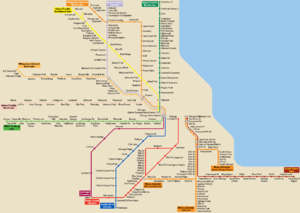
The line operates over the tracks of the Metra Electric Line from Millennium Station to Kensington - 115th Street. Metra owns the track in this territory. As part of a non-compete clause with Metra, outbound South Shore Line trains to Indiana are boarding only at Metra Electric stations; inbound trains to Millennium Station are discharge-only.
South Shore Line trains make the following station stops: (not all trains stop at all stations)[27]
| Station | Location | Notes |
|---|---|---|
| Millennium Station | Chicago, Illinois | Connections Metra: Metra Electric CTA Bus: 4, 6, 19, 20, 26, 60, N66, 124, 129, 143, 145, 147, 148, 151, 157 CTA "L": Red, Brown, Green, Orange, Purple, Pink Lines Pace: 855 ChicaGo Dash |
| Van Buren Street | Chicago, Illinois | Connections Metra: Metra Electric CTA Bus: 1, 3, 4, 6, 7, 14, 26, X28, 126, 129, 130, 132, 145, 147, 148, 151 |
| Museum Campus/11th Street | Chicago, Illinois | Connections Metra: Metra Electric CTA Bus: 1, 3, 4, 12, 129, 130, 146 |
| McCormick Place | Chicago, Illinois | Flag Stop. Service provided on weekends only Connections Metra: Metra Electric CTA Bus: 3, 21 |
| 53rd Street | Chicago, Illinois | South Shore service withdrawn October 16, 1966, replaced by 57th Street |
| 57th Street (Hyde Park) | Chicago, Illinois | Connections Metra: Metra Electric CTA Bus: 15, 28, 55, 170, 171 |
| 63rd Street | Chicago, Illinois | Flag Stop. Limited service provided Connections Metra: Metra Electric CTA Bus: 63 |
| Kensington - 115th Street | Chicago, Illinois | South Shore service withdrawn February 15, 2012 |
| Hegewisch | Chicago, Illinois | Connections CTA Bus: 30 Pace: 355, 358, 364 |
| Hammond | Hammond, Indiana | |
| East Chicago | East Chicago, Indiana | Connections East Chicago Transit: 1, 2, 4 |
| Gary Airport/Clark Road | Gary, Indiana | Flag stop Connections GPTC: 12 |
| Ambridge | Gary, Indiana | Closed July 5, 1994 |
| Gary Metro Center | Gary, Indiana | Connections GPTC: 1, 6, 12, 13, 17, 18, 19, 22, 23 |
| Miller | Gary, Indiana | Connections GPTC: 13 |
| Portage/Ogden Dunes | Ogden Dunes/Portage, Indiana | |
| Dune Acres | Porter County, Indiana | Closed 1994 |
| Dune Park | Porter, Indiana | Connections V-Line: Orange Line route (Friday-Sunday only) |
| Kemil Road | Porter County, Indiana | Closed July 5, 1994 |
| Beverly Shores | Beverly Shores, Indiana | Flag Stop |
| Willard Avenue | Michigan City, Indiana | Closed July 5, 1994 |
| 11th Street | Michigan City, Indiana | Connections Michigan City Transit: 1, 2, 4 |
| Carroll Avenue | Michigan City, Indiana | Connections Michigan City Transit: 3 |
| LaLumiere | LaPorte County, Indiana | Closed July 5, 1994 |
| Rolling Prairie | Rolling Prairie, Indiana | Closed July 5, 1994 |
| Hudson Lake | Hudson Lake, Indiana | Flag stop |
| New Carlisle | New Carlisle, Indiana | Closed July 5, 1994 |
| South Bend Airport | South Bend, Indiana | Connections Greyhound Bus Coach USA TRANSPO: 4 Allegiant Air Delta Connection United Express |
| South Bend | South Bend, Indiana | South Shore service withdrawn November 21, 1992. Current Amtrak station. |
| South Bend | South Bend, Indiana | Closed 1970. Located in downtown South Bend. |
Notes
- ↑ http://www.in.gov/indot/files/Transit_2013PublicTransitReport.pdf
- 1 2 3 "Chicago South Shore and South Bend Railroad (NICTD)". southshore.railfan.net.
- ↑ Ogorek 2012, p. 9
- ↑ Middleton 1998, pp. 6–7
- ↑ Middleton 1998, p. 8
- ↑ Economic Adjustment Study: Chicago South Shore and South Bend Railroad Corridor, Final Report; Northwestern Indiana Regional Planning Commission and Northern Indiana Commuter Transportation District,; March 1980; pg 1
- ↑ "South Shore Line Switch Approved". Chicago Tribune. December 23, 1966. p. 2 Section 10.
- ↑ Wieland, Phil (21 November 1992). "New train terminal could have folks heading east, young". The Times of Northwest Indiana. Retrieved 15 February 2015.
- ↑ Dodson, Paul (June 17, 1994). "South Shore Railroad Will Close 7 Flagstops". South Bend Tribune. p. B2.
- ↑ "NICTD Board Meeting Minutes July 31, 2009" (PDF). Northern Indiana Commuter Transportation District. July 31, 2009. Retrieved September 11, 2010.
- ↑ "August 7–9, 2010 Temporary Weekend Outage Cancelled" (PDF). Northern Indiana Commuter Transportation District. July 22, 2010. Retrieved August 7, 2010.
- ↑ Allen, Kevin (3 February 2015). "Chicago express a major step for South Shore". South Bend Tribune. Retrieved 15 February 2015.
- ↑ "Detailed Line Map" (PDF). SouthShore.Railfan.net. February 2012. Retrieved May 24, 2016.
- ↑ Steele, Andrew (May 19, 2016). "Feds OK South Shore double-track project development". The Times of Northwest Indiana. Archived from the original on May 24, 2016. Retrieved May 24, 2016.
- ↑ "2013 Indiana Public Transit Annual Report" (PDF). Indiana Department of Transportation. August 2014. p. 111. Retrieved 15 February 2015.
- ↑ Randall, W. David (1974). Railway Passenger Car Annual, Volume I, 1973-1974. Park Forest, IL: RPC Publications. pp. 74–75.
- ↑ "Fare Policies". Northern Indiana Commuter Transportation District. Retrieved 15 February 2015.
- ↑ "NEW METRA FARES TAKE EFFECT AT HEGEWISCH" (PDF). Northern Indiana Commuter Transportation District. 1 February 2015. Retrieved 15 February 2015.
- ↑ Maddux, Stan (February 14, 2008). "Michigan City weighs South Shore track route". Post-Tribune. Retrieved February 18, 2008.
- ↑ South Shore re-route map
- ↑ Wink, Laurie (June 9, 2009). "More South Shore details released". The News Dispatch. Retrieved August 22, 2009.
- ↑ Ebaugh, Alicia (March 25, 2010). "Funding dire for South Shore study". The News Dispatch. Retrieved March 26, 2010.
- ↑ Field, Matt (August 17, 2010). "City prepares to study South Shore routes". The News Dispatch. Retrieved August 19, 2010.
- ↑ Field, Matt (January 28, 2011). "Bids sought for NICTD study". The News Dispatch. Retrieved February 9, 2011.
- ↑ "Michigan City/NICTD Rail Realignment Study" (PDF).
- ↑ Benman, Keith (December 17, 2008). "Study: Valpo-to-Munster SS line would add few riders". The Times of Northwest Indiana. Retrieved September 1, 2009.
- ↑ Economic Adjustment Study: Chicago South Shore and South Bend Railroad Corridor, Final Report; Northwestern Indiana Regional Planning Commission and Northern Indiana Commuter Transportation District,; March 1980; Appendix A
References
- Middleton, William D. (1998). "Insull's Super-Interurban". In Cohen, Ronald D.; McShane, Stephen G. Moonlight in Duneland: The Illustrated Story of the Chicago South Shore and South Bend Railroad. Indiana University Press. ISBN 0-253-33418-7. OCLC 38862554.
- Ogorek, Cynthia L. (2012). Along the Chicago South Shore & South Bend Rail Line. Images of America. Charleston, SC: Arcadia Publishing. ISBN 978-0-738-59419-4. OCLC 796757417.
- Van Hattem, Matt (July 5, 2006). "South Shore Line - The commuter railroad linking Chicago and South Bend, Ind.". Trains.
- Hammond, Indiana News Briefs November 2003
- Northern Indiana Commuter Transportation District – Our History
- Chicago South Shore and South Bend Railroad – A Brief History
External links
| Wikimedia Commons has media related to South Shore Line. |
- Northern Indiana Commuter Transportation District
- Chicago, Illinois / South Bend, Indiana: The South Shore Line

